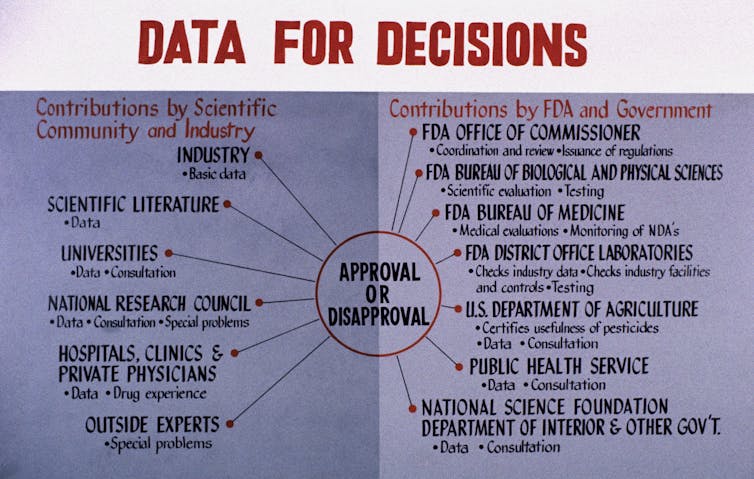Challenging the FDA’s authority isn’t new – the agency’s history shows what’s at stake when drug regulation is in limbo
Political pressure is nothing new for the U.S. Food and Drug Administration. The agency has frequently come under fire for its drug approval decisions, but attacks on its decision-making process and science itself have increased during the COVID-19 pandemic.
Recent challenges to the FDA’s authority have emerged in the context of reproductive rights.
On Nov. 18, 2022, a group of anti-abortion doctors and medical groups filed a lawsuit against the FDA, challenging its approval from more than 20 years ago of mifepristone, a drug taken in combination with another medication, misoprostol, to treat miscarriages and used to induce more than 50% of abortions in early-stage pregnancies in the U.S.
It is widely believed that the plaintiffs filed the lawsuit in the Northern District of Texas so District Judge Matthew J. Kacsmaryk, a well-known abortion opponent, could oversee the litigation. While Kacsmaryk did issue a preliminary injunction ruling that the FDA lacked the authority to approve mifepristone, an appeal partially reversed the decision and the Supreme Court stayed Kacsmaryk’s order. The case now sits at the 5th U.S. Circuit Court of Appeals and will likely return to the Supreme Court.
The FDA is the government’s oldest consumer protection agency. The effects of this lawsuit could reach far beyond mifepristone – undermining the agency’s authority could threaten its entire drug approval process and change access to commonly used drugs, ranging from amoxycillin and Ambien to prednisone and Paxlovid.
I am a legal scholar whose research focuses in part on the law and ethics of the FDA’s drug approval process. Examining the FDA’s history reveals the unprecedented nature of the current challenges to the agency’s authority.

The U.S. Food and Drug Administration/Flickr
Events shaping FDA’s focus on safety
In its early years, the FDA focused primarily on balancing the competing goals of consumer safety with access to experimental treatments. The priority was strengthening consumer protection to prevent tragedy from recurring.
For instance, at the turn of the 20th century, Congress passed the Biologics Control Act of 1902, providing the federal government the authority to regulate vaccines. This law was introduced after 13 children died from inadvertently contaminated diphtheria antitoxin, which was made from the blood of a horse infected with tetanus.
A few years later, after investigative journalists publicized the unsanitary conditions and food-handling practices in meatpacking plants, Congress passed the Pure Food and Drug Act of 1906, which prohibited the marketing and sale of misbranded and contaminated foods, drinks and drugs.
Similarly, in 1937, approximately 71 adults and 34 children died from ingesting S.E. Massengill’s antibacterial elixir, which contained a poisonous raspberry flavoring added to sweeten the taste. In response, Congress passed the Federal Food, Drug and Cosmetic Act of 1938, requiring manufacturers to show that drugs are safe before they go on the market. This act marked the beginning of modern drug regulations and the birth of the FDA as a regulatory agency.
Then, in 1962, Dr. Frances Oldham Kelsey, a pharmacologist, physician and medical officer working at the FDA, refused to approve thalidomide, a drug marketed in Europe, Canada, Japan and other countries to alleviate morning sickness in pregnant women but later found to cause severe birth defects. Shocking revelations of children born without limbs or suffering from other debilitating conditions motivated Congress to pass the Kefauver-Harris Drug Amendments of 1962, which ushered in a more cautious approach to the drug approval process.
FDA’s turn toward expanding access
During the 1970s, questions about the limits of safety versus an individual’s right to access arose when cancer patients who wanted access to an unapproved drug derived from apricots, Laetrile, sued the FDA. The agency had blocked the drug’s shipment and sale because it was not approved for use in the U.S. At that time, the Supreme Court upheld the FDA’s protective authority, holding that an unproven therapy is unsafe for all patients, including the terminally ill.
The 1980s, however, marks the FDA’s shift toward increasing access following reports of an emerging disease – AIDS – which primarily affected gay men. In the first nine years of the AIDS epidemic, over 100,000 Americans died. AIDS patients and their advocates became vocal critics of the FDA, arguing that the agency was too paternalistic and restrictive following events like the thalidomide scare.

Mikki Ansin/Peter Ansin via Getty Images
After massive protests, Dr. Anthony Fauci, then director of the National Institute of Allergy and Infectious Diseases, proposed a parallel track program allowing eligible patients access to unapproved experimental treatments. This, along with other existing FDA mechanisms, helped lay the path for other alternative approval pathways, such as Emergency Use Authorization, which played a large role in permitting use of vaccines and medications pending full FDA approval during the COVID-19 pandemic.
Future of the FDA
Despite the FDA’s shift toward increased access, the political right has in recent years argued that the agency remains too bureaucratic and paternalistic and should be deregulated – an argument seemingly contrary to the reasoning underlying Kacsmaryk’s recent order that the FDA did not sufficiently evaluate the safety of mifepristone in its approval.
Mifepristone, which has overwhelming data supporting its safety, could remain available to some people in some states regardless of the outcome of this lawsuit. While the FDA approves drugs for consumer use, it does not regulate the general practice of medicine. Doctors can prescribe FDA-approved drugs off-label, meaning they could prescribe a drug with a different dose, in a different way or for a different use than what the FDA has approved it for.
The mifepristone case has broad implications for the FDA’s future and could have devastating effects on health in the U.S. Due in part to FDA involvement, public health interventions have led to a 62% increase in life expectancy in the 20th century. These include vaccines and medications for childhood illnesses and infectious diseases such as HIV, increased regulation of tobacco, and over-the-counter Narcan to combat the opioid crisis, among others.
The FDA needs to be able to use its scientific expertise to make data-driven decisions that balance safety and access, without the ability of a single judge to potentially gut the system. The agency’s history is an important reminder of the need for strong administrative agencies and ongoing vigilance to protect everyone’s health.
For all the latest Health News Click Here
For the latest news and updates, follow us on Google News.
